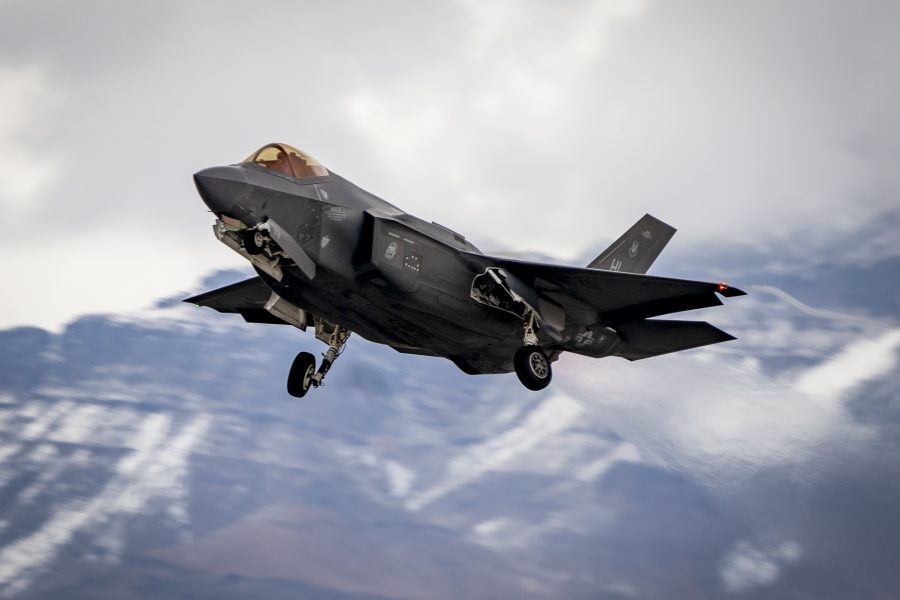The next three lots of F-35 production—now being negotiated—likely won’t see much, if any, lowering of unit prices, Lockheed Martin aeronautics vice president Gregory M. Ulmer said Feb. 19.
A reduction in units being procured and an increase in capability of the aircraft will make it tough to keep the price from rising, he said.
“If you look at the next three lots, there’s going to be quite a bit of pressure, I would say, keeping the cost neutral,” Ulmer told journalists on a telecon press conference ahead of AFA’s virtual Aerospace Warfare Symposium Feb. 24-26.
There’s “a significant quantity reduction in the next three years … on the order of 100 aircraft,” he said, so there will be fewer aircraft across which to spread overhead costs.
In the Lot 12, 13, and 14 deal, announced in October 2019, there were 478 aircraft, and Lockheed’s unit price for the F-35A model fell below $80 million apiece for the first time. The Lot 12-14 contract reduced F-35 unit prices nearly 13 percent over the previous lots, and marked the sixth successive year of unit price reductions.
“We also know we’re going to put Tech Refresh 3 [upgraded software, improved core processor, new cockpit display] and new capabilities on the aircraft” in Lots 15-17, Ulmer said. Given all that, “We’re working to keep a cost-neutral position” for the next production lots.
The Joint Program Office reported in January that its contracting strategy for Lots 15-17 will be to negotiate a “base year” contract for Lot 15, with two single-year options in Lots 16 and 17.
The F-35 still has not been declared ready for full-rate production; that status has been repeatedly delayed while the Pentagon integrates the aircraft with the Joint Simulation Environment, a Pentagon wargaming system that assesses the right numbers of various platforms for various combat scenarios.
Declaring the F-35 ready for full-rate production will make it possible for a multi-year contract of five to seven years, Ulmer said, noting that partners are already taking advantage of block buy quantities to reduce risk. That arrangement would enable contractors and subs to make better deals for materials and labor, which could hold prices down, he said.
Asked if declaration of full-rate production readiness would enhance the image of the F-35 worldwide, Ulmer said, “From my view, it’s already …happened,” citing the success of the F-35 in real-world combat operations in the U.S. Central Command area of operations, and the fact that the program has ramped up production steadily and “met all our commitments.” He noted, though, that the COVID-19 pandemic affected the ramp rate, and previously acknowledged that Lockheed fell 20 airplanes short of its planned deliveries in 2020.
Turkey’s removal from the F-35 program won’t affect foreign sales prospects. The U.S. Air Force will buy the aircraft built in production line positions previously held by Turkey, said Ulmer.
The Turkish slots “are spoken for,” Ulmer said. “At the time we stepped away from Turkey, there were eight aircraft” completed for that country. “Those have all been … delivered to the U.S Air Force.” There were also three lots of eight aircraft for Turkey “in flow,” and “all those will be [delivered] to the U.S. Air Force as well. There is no plan to allocate those to a different customer,” Ulmer reported.
There are numerous potential F-35 customers in the Middle East and Far East, Ulmer said, declining to be specific.
Ulmer said Lockheed is awaiting a request for proposals in the spring from the F-35 Joint Program Office on a Performance-Based Logistics plan the company pitched to the Pentagon two years ago. The plan would see Lockheed invest more than a billion dollars up-front in sustainment enhancements, and the government would pay the company back out of its operating savings. Lockheed said at the outset the PBL plan is the only way to achieve a cost per flying hour of $25,000 by 2025, and Ulmer said that goal is “still doable.”
He also said Lockheed has a backlog of 128 F-16s to be produced at its new Greenville, S.C., F-16 production facility for five customer countries, and there is a potential to sell as many as 300 more, although some of the customers will be “repeat” buyers. That figure doesn’t include India, which may build an advanced F-16, called the F-21, under license. New customers include Bulgaria and Slovakia, Ulmer said.
Asked to comment on Air Force Chief of Staff Gen. Charles Q. Brown’s announcement of a new tactical aircraft study, Ulmer said he agrees with Brown’s “approach, relative to the operational analysis and the study aspect” but believes it should take a holistic view of air combat.
“I tend to think it’s a system of systems, and not so much a platform-centric solution set,” he said. As to Brown’s suggestion that the Air Force may need a generation 4-plus or 5-minus platform to succeed the F-16, Ulmer said “if you fast-forward to the next decade, I think the ‘low end’ fight in the future is very much a ‘high-end’ fight. If you look at the proliferation of [Russian air defense] S-300 or S-400 [systems] … it’s going to be even more so in the future.”
